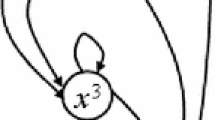Abstract
By choosing a dynamical system with d different couplings, one can rearrange a system based on the graph with a given vertex dependent on the dynamical system elements. The relation between the dynamical elements (coupling) is replaced by a relation between the vertexes. Based on the E 0 transverse projection operator, we addressed synchronization problem of an array of the linearly coupled map lattices of identical discrete time systems. The synchronization rate is determined by the second largest eigenvalue of the transition probability matrix. Algebraic properties of the Bose-Mesner algebra with an associated scheme with definite spectrum has been used in order to study the stability of the coupled map lattice. Associated schemes play a key role and may lead to analytical methods in studying the stability of the dynamical systems. The relation between the coupling parameters and the chaotic region is presented. It is shown that the feasible region is analytically determined by the number of couplings (i.e. by increasing the number of coupled maps, the feasible region is restricted). It is very easy to apply our criteria to the system being studied and they encompass a wide range of coupling schemes including most of the popularly used ones in the literature.
Similar content being viewed by others
References
K Kaneko, Phys. Lett. A111, 321 (1985)
Li Wentian, J. Statist. Phys. 68, 829 (1992)
M G Cosenza and A Parravano, Phys. Rev. E64, 036224 (2001)
A M Dos Santos, R L Viana, S R Lopes, S E de S Pinto and A M Batista, Physica A367, 145 (2006)
S Monteb, F Dovidioc, H Chate and E Mosekildea, Physica D205, 25 (2005)
D Coca and S A Billings, Phys. Lett. A315, 61 (2003)
G Rangarajan and M Ding, Phys. Lett. A296, 204 (2002)
Y Chen et al, Phys. Rev. E67, 026209 (2003)
R A Bailey, Association schemes: Designed experiments, algebra and combinatorics (Cambridge University Press, Cambridge, 2004)
C Godsil, Algebraic combinatorics (Chapman and Hall, New York, 1993)
C Godsil and G Royle, Algebraic graph theory (Springer, New York, 2001)
Prashant M Gade and Chin-Kun Hu, Phys. Rev. E73, 036212 (2006)
A Shabunin and V Astakhov, Phys. Rev. E72, 016218 (2005)
L M Pecora and T L Carroll, Phys. Rev. Lett. 64, 821 (1990)
A Jafarizadeh, S Behnia, S Khorram and H Nagshara, J. Stat. Phys. 104(516), 1013 (2001)
M A Jafarizadeh and S Behnia, J. Nonlinear Phys. 9, 26 (2002)
M A Jafarizadeh and S Behnia, Phys. Lett. A310, 168 (2003)
V M Gundlachi and D A Rand, Nonlinearity 6, 215 (1993)
J R Dorfman, An introduction to chaos in nonequilibrium statistical mechanics (Cambridge University Press, Cambridge, 1999)
G Keller, Equilibrium states in ergodic theory (Cambridge University Press, Cambridge, 1998) p. 23
M Sonis and S Zhoub, Physica D165, 12 (2002)
P Y Tong and K W Yu, Phys. Lett. A280, 139 (2001)
S Boyd and L Vandenberghe, Convex optimization (Cambridge University Press, Cambridge, 2004)
M A Jafarizadeh, Physica A287, 1 (2000)
L T Gruyitch and R Bouyekhf, Nonlinear Analysis 42, 487 (2000)
R E Amritkar, S Jalan and C Hu, Phys. Rev. E72, 016212 (2005)
T Y Li and J A Yorke, Am. Math. Monthly 82, 481 (1975)
F R Marotto, J. Math. Anal. Appl. 63, 199 (1978)
G De Barra, Measure theory and integration (John Wiley & Sons, New York, 1981)
Ming-Chung Ho, Yao-Chen Hung and I-Min Jiang, Phys. Lett. A324, 450 (2004)
N Guptea, A Sharmaa and G R Pradhanb, Physica A318, 85 (2003)
S Morita, K Oshiob, Y Osanac, Y Funabashic, K Okac and K Kawamura, Physica A298, 553 (2001)
M A Jafarizadeh, Euro. Phys. J. B4, 103 (1998)
Fuzhen Zhang, Matrix theory. Basic results and techniques (Springer, New York, 1999)
M Jiang and Y B Pesin, Commun. Math. Phys. 193, 675 (1998)
Author information
Authors and Affiliations
Corresponding author
Rights and permissions
About this article
Cite this article
Jafarizadeh, M.A., Behnia, S., Faizi, E. et al. Generalized N-coupled maps with invariant measure in Bose-Mesner algebra perspective. Pramana - J Phys 70, 417–438 (2008). https://doi.org/10.1007/s12043-008-0059-3
Received:
Revised:
Accepted:
Published:
Issue Date:
DOI: https://doi.org/10.1007/s12043-008-0059-3




